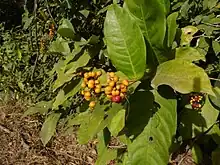| Ixora brachypoda | |
|---|---|
 | |
| Scientific classification | |
| Kingdom: | Plantae |
| Clade: | Tracheophytes |
| Clade: | Angiosperms |
| Clade: | Eudicots |
| Clade: | Asterids |
| Order: | Gentianales |
| Family: | Rubiaceae |
| Genus: | Ixora |
| Species: | I. brachypoda |
| Binomial name | |
| Ixora brachypoda DC. | |
Ixora brachypoda is a species of shrub or small tree in the family Rubiaceae. It has fragrant flowers and glabrous leaves and stems.[1]
Description
The species grows up to 6 m in height. The bark is brown with longitudinal scaly fissures and the slash has a yellow to whitish color.[2] Leaves, sessile or subsessile with stipules and petioles present; stipules reaches up to 3 mm wide and 2 mm long while petiole reaches 2 mm long. Leaflets are elliptic to ovate in outline, up to 27 cm long and 14 cm wide with an acuminate apex and cuneate base.[2] The inflorescence is corymbose and many flowered, sometimes with more than 200 flowers, corolla is tubular, white, sometimes tinged with pink. The fruit is globular in shape, up to 9 mm wide and 8 mm long, reddish black when ripe.[2]
Distribution
Occurs in West and Central Africa, from Guinea Bissau to the Democratic Republic of Congo. Found in gallery forests and along streams.[2]
Uses
In ethnomedicine, bark extracts of Ixora brachypoda are used in pain management, while root extracts are used as an antihelminthic and also to aid the healing process.[3]
References
- ↑ "Ixora brachypoda DC. | Plants of the World Online | Kew Science". Plants of the World Online. Retrieved 2023-12-11.
- 1 2 3 4 Arbonnier, Michel; Arbonnier, Michel (2004). Trees, shrubs and lianas of West African dry zones. CIRAD. Weikersheim: Margraf Publ. p. 452. ISBN 978-2-87614-579-5.
- ↑ Bhat, Meghashyama; Chakraborty, Bidhayak; Kumar, Raju Suresh; Almansour, Abdulrahman I.; Arumugam, Natarajan; Kotresha, D.; Pallavi, S.S.; Dhanyakumara, S.B.; Shashiraj, K.N.; Nayaka, Sreenivasa (2021). "Biogenic synthesis, characterization and antimicrobial activity of Ixora brachypoda (DC) leaf extract mediated silver nanoparticles". Journal of King Saud University - Science. 33 (2): 101296. doi:10.1016/j.jksus.2020.101296.